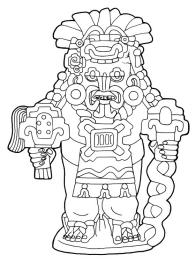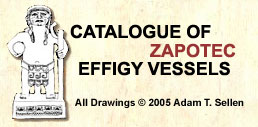| Key: ROM 1399 | | Actual Location: Royal Ontario Museum, Toronto, Canada. | | Collection: Constantino Rickards | | Registration: HM 1399 | | Provenance: Santo Domingo Galiesa, District of Ocotlán, Oaxaca. | | Measurements: 43.2 cm. | | Color: Light grey clay with a light grey coating. | | Chronology: Xoo 600 - 800 AD | | Click to view Chronology | | Reference: Photo from the Rickards Collection circa 1917; Rickards 1938: 164, plate V (Rickards published a copy of this piece); Treasures of Pre-Columbian Art 1959: no. 547; Woeller 1960: plate 28; Boos 1968a: vol. III, plate XI; Sellen 1999: fig. 1, 2002a. | | Comments: This piece has been forged with copies. The copies are in various collections in Europe and most of them have been proven false thanks to the TL test (cf. Schuler-Schömig 1970: 8, plate II, for the piece in Berlin and Mongne 1987: 25-26, fig. 10, for an example of the four pieces in Paris). Rickards (1938: 164) reports that four vessels like this one came out of a tomb in Santo Domingo. If this information is true, then the location of the other three original pieces is unknown. | | Glyphs: Glyph C in the headdress. The glyph on one side of the head is unknown. The glyph for corn in the right hand. In the left hand, possibly another unknown plant, maybe it is the young corn (cf. Sellen 2002b). | | Dating: TL by Shaplin and Zimmerman, 1978, test #21: authentic; TL by Lazos, Ortiz, Ruvalcaba and Sellen 1999, test #110375: authentic. | |
| | 
Click to view high resolution in a new window
select this image for review |
